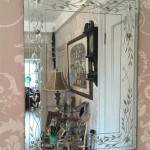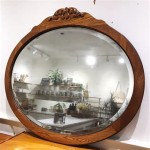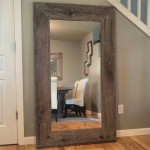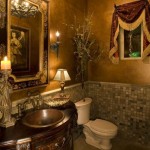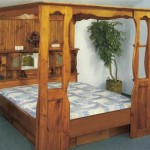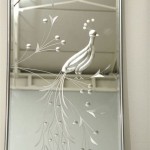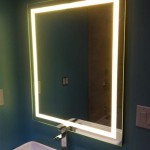Mirror Size for Dining Room Wall
Mirrors are a versatile design element, capable of transforming a space by amplifying light and creating an illusion of spaciousness. When incorporating a mirror into a dining room, selecting the appropriate size is crucial for achieving the desired aesthetic and functional impact. Several factors influence the ideal mirror dimensions, including the size of the dining table, the wall space available, and the overall design scheme.
The dining table serves as the focal point of the dining room, and the mirror should complement, not overwhelm, this central element. A common guideline is to choose a mirror that is slightly narrower than the table itself. This proportion ensures that the mirror doesn't dominate the space, allowing the table to retain its prominence. For instance, a 60-inch wide table could be paired with a mirror between 48 and 54 inches wide. This creates a balanced visual relationship between the two elements.
The available wall space dictates the maximum dimensions of the mirror. Measuring the wall space before selecting a mirror prevents the piece from appearing cramped or disproportionately large. Leave sufficient space between the mirror's edges and any surrounding architectural features, such as windows, doorways, or wall moldings. This negative space allows the mirror to breathe and prevents a cluttered appearance. A general rule is to maintain a few inches of space on each side of the mirror.
Ceiling height plays a role in determining the appropriate mirror height. In rooms with lower ceilings, opting for a horizontally oriented mirror can visually widen the space. Conversely, in rooms with high ceilings, a vertically oriented mirror can emphasize the vertical dimension and add a sense of grandeur. The bottom edge of the mirror should ideally be positioned a few feet above the tabletop, allowing diners to comfortably view their reflections without obstruction.
The overall design scheme of the dining room influences the choice of mirror size. In minimalist or contemporary settings, a large, simple mirror can enhance the clean lines and uncluttered aesthetic. In more traditional or ornate settings, a smaller, more decorative mirror might be a better fit. The mirror frame should complement the existing décor, whether it's a sleek metal frame for a modern space or an intricately carved wooden frame for a traditional space.
Beyond the basic dimensional considerations, the shape of the mirror can also impact the dining room's aesthetic. Round or oval mirrors can soften the angular lines of a rectangular table, while square or rectangular mirrors can reinforce a sense of order and symmetry. Unconventional shapes, such as arched or geometric mirrors, can add a touch of personality and visual interest.
The function of the mirror should also be considered. While the primary purpose of a dining room mirror is often decorative, it can also serve a functional purpose by reflecting light and brightening the space. Positioning the mirror strategically to reflect natural light from a window or artificial light from a chandelier can significantly enhance the room's illumination. A larger mirror will generally reflect more light than a smaller one.
When selecting a mirror size, consider the scale of other decorative elements in the room. The mirror should be proportionate to artwork, lighting fixtures, and other wall décor. Avoid choosing a mirror that is significantly larger or smaller than other elements, as this can create visual imbalance. Maintaining a sense of scale and proportion among all decorative elements creates a cohesive and harmonious design.
Budget is a practical consideration that often influences the size of the mirror. Larger mirrors generally command higher prices than smaller mirrors, especially if they are made with high-quality materials or feature intricate designs. Setting a budget beforehand can help narrow down the options and ensure that the chosen mirror fits within the allocated budget constraints. Exploring different retailers and comparing prices can help identify the best value for the desired size and style.
Ultimately, choosing the right mirror size for a dining room wall involves a careful balance of aesthetic and practical considerations. By considering the size of the dining table, available wall space, ceiling height, design scheme, mirror shape, function, scale of other décor elements, and budget, it's possible to select a mirror that enhances the dining room's beauty and functionality. Careful planning and consideration of these factors contribute to a well-designed and visually appealing dining space.

How To Choose The Best Dining Room Mirror Image Inspirations
:strip_icc()/dining-room-mirror-ideas-1-ashley-montgomery-b90b98cab74443e9ab4f9d5e9f6ac2d2.jpeg?strip=all)
17 Dining Room Mirror Ideas That Ll Dress Up Your Walls

Should I Need A Dining Room Mirror Ideas

Tips On How High To Hang A Mirror Interior Design Blog Hadley Court

How To Choose The Best Dining Room Mirror Image Inspirations

Diy Full Length Mirror Dining Room Wall Decor Home

Transform Your Dining Room With A Mirror Decoholic

5 Mirror Vastu Placement Tips For A Happy Home Livspace

49 Best Dining Room Mirror Wall Ideas Decor

Customized Size Mirror Polishing Wall Metal Sculptures Art For Home Decorative Modern China Sitting Room Decor And Coffee Table Accessories Made In Com

